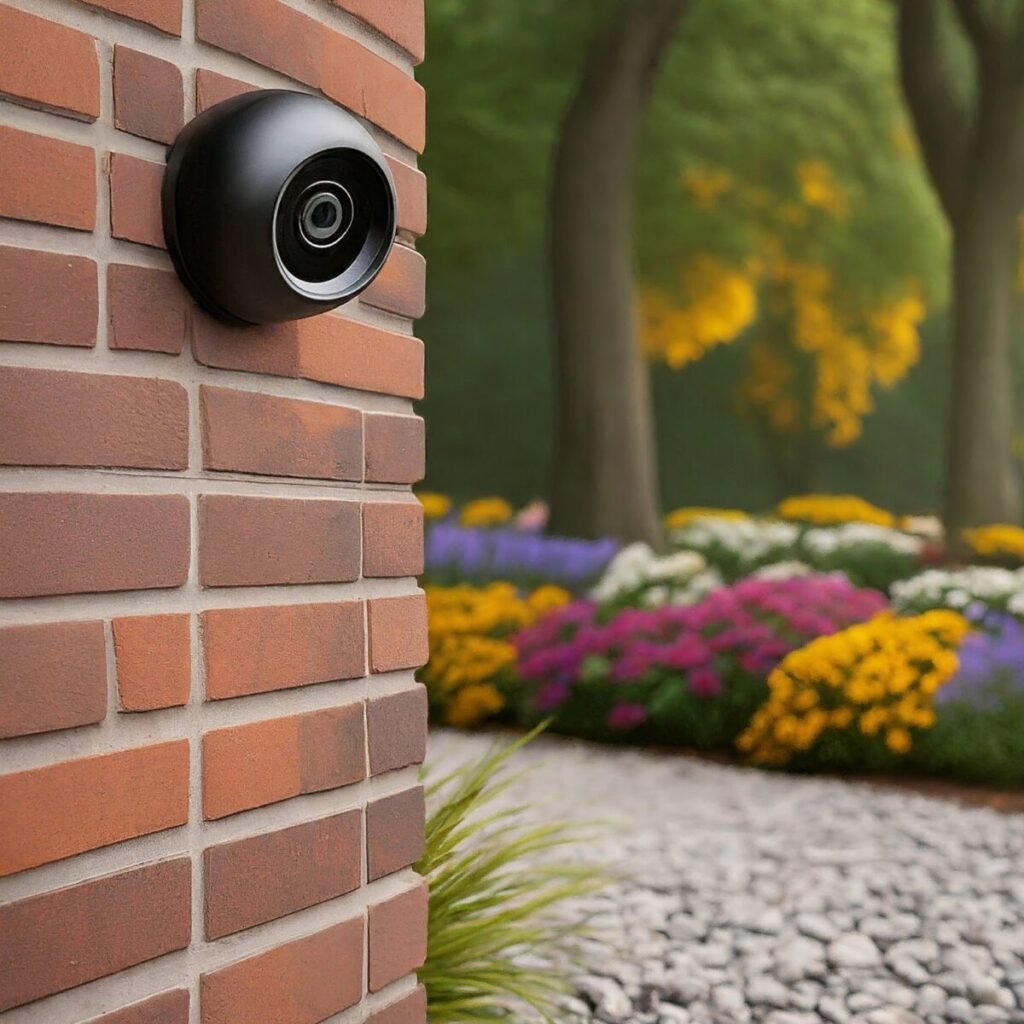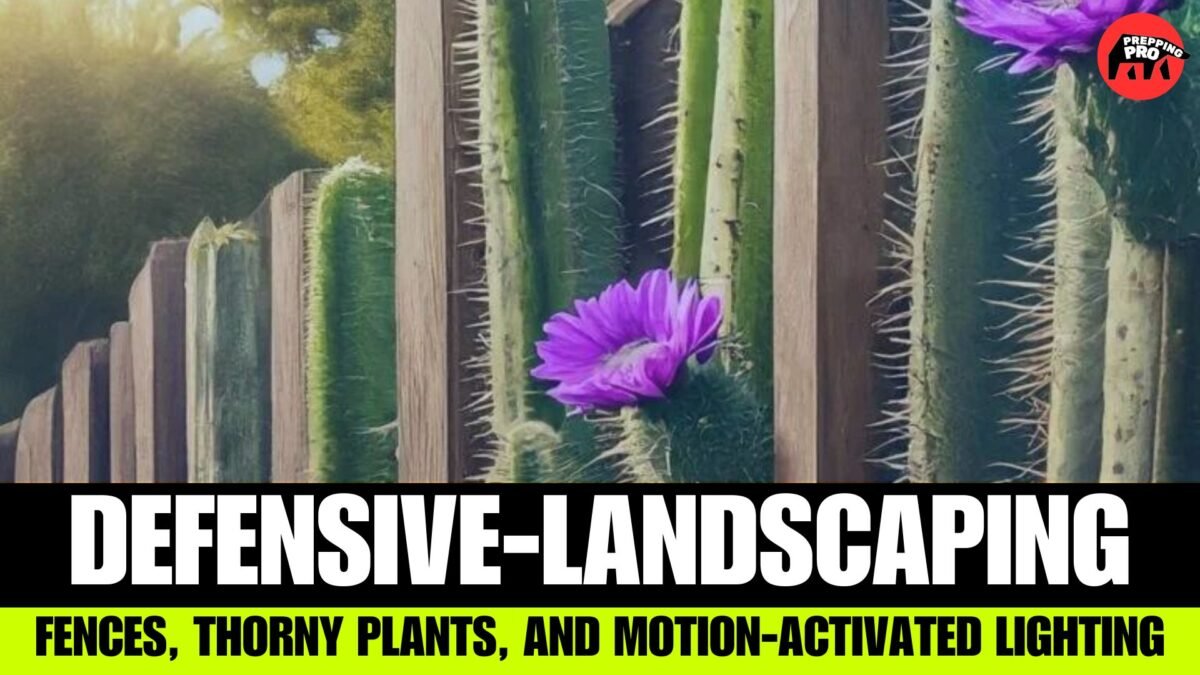In this article, we will tackle the topic of defensive landscaping, a powerful technique that not only enhances the beauty of your home but also safeguards it against potential threats.
By implementing specific techniques and strategies, you can create a secure perimeter that provides peace of mind while adding value to your property.
Key Takeaways:
- Defensive landscaping is a technique that combines security and aesthetics to protect your home.
- By strategically incorporating elements like fences, thorny plants, and motion-activated lighting, you can deter intruders.
- Creating a secure perimeter is crucial, and features like dense shrubs and decorative fences can help.
- Natural surveillance, lighting, and low-maintenance materials are essential considerations for a defensive landscape.
- Security structures, natural barriers, and access control measures provide additional layers of protection.
Now, let’s dive into the details and explore the importance of defensive landscaping and how you can master this art to safeguard your home.
Table of Contents
The Importance of Defensive Landscaping

When it comes to protecting your home, defensive landscaping offers a range of secure solutions.
By incorporating protective landscaping ideas and safety-focused landscape design, you can create a landscape that not only enhances the aesthetic appeal of your property but also acts as a fortress-like defense against potential threats.
One of the key advantages of defensive landscaping is increased privacy.
By strategically placing trees, shrubs, and other foliage, you can create a natural barrier that shields your property from prying eyes.
This not only deters potential intruders but also creates a sense of seclusion and tranquility in your outdoor space.
In addition to privacy, the deterrence of potential intruders is another significant benefit of defensive landscaping.
By incorporating elements such as fences, thorny plants, and motion-activated lighting, you create a visually intimidating landscape that makes it less appealing for would-be intruders to target your property.
This layer of protection can greatly enhance the overall security of your home.
Table: Benefits of Defensive Landscaping
| Benefits | Description |
|---|---|
| Increased privacy | Create a natural barrier and shield your property from prying eyes |
| Deterrence of intruders | Visually intimidating landscape that makes your property less appealing |
| Protection against natural elements | Strategic landscaping to safeguard against extreme weather conditions |
Furthermore, defensive landscaping provides protection against natural elements.
By strategically planting trees and shrubs, you can create a buffer against strong winds, heavy rain, and other weather-related risks.
This not only helps preserve the structural integrity of your home but also protects your outdoor living spaces and garden from potential damage.
In conclusion, secure landscaping solutions through defensive landscaping techniques offer a wide range of benefits.
From increased privacy and deterrence to protection against natural elements, a safety-focused landscape design can significantly enhance the security and aesthetics of your property.
Designing a Secure Perimeter

Safeguarding your property with landscaping involves creating a secure perimeter that deters potential intruders and protects your home.
By strategically selecting and positioning plants and structures, you can create physical barriers and discourage unauthorized access.
To enhance the security of your landscape, consider incorporating dense shrubs and prickly hedges.
These natural barriers can create obstacles for intruders and make it more difficult for them to enter your property.
Additionally, decorative fences can serve both aesthetic and security purposes, providing an extra layer of protection.
Benefits of a Secure Perimeter
- Enhanced security: A well-designed perimeter deters potential intruders and increases the overall security of your property.
- Privacy: By creating a secure perimeter, you can enjoy increased privacy and peace of mind.
- Property delineation: A clear boundary helps define your property and prevents encroachment.
- Controlled access: By controlling entry points and access, you can better manage who enters your property.
To ensure the effectiveness of your secure perimeter, it’s important to regularly maintain and inspect your landscape.
Trim vegetation as needed, repair any damage to fences or structures, and ensure that security features, such as lighting and cameras, are functioning properly.
Regular upkeep will help maintain the integrity and security of your landscape over time.
| Key Considerations for a Secure Perimeter | Examples |
|---|---|
| Positioning of shrubs and hedges | Strategically planting dense shrubs along the perimeter creates a physical barrier and serves as a deterrent. |
| Decorative fences | Installing a decorative fence not only enhances the aesthetics of your landscape but also provides an extra layer of security. |
| Security gates | Consider installing secure gates at entrances to control access to your property. |
Creating a secure perimeter through landscaping is an effective way to safeguard your property.
By carefully incorporating natural barriers, decorative fences, and other security features, you can enhance the security of your landscape and provide peace of mind for you and your family.
Incorporating Natural Surveillance

When it comes to ensuring the security of your home, incorporating natural surveillance into your landscape design can be a highly effective strategy.
Natural surveillance involves creating a landscape that maximizes visibility and enables you to monitor the surroundings of your property.
By strategically placing low-growing trees and shrubs, trimming vegetation near windows, and installing outdoor cameras, you can enhance visibility and deter criminal activity.
Low-growing trees and shrubs not only add beauty to your landscape but also prevent potential intruders from hiding or approaching your home without being seen.
By selecting plants that maintain a manageable height, you can maintain clear lines of sight while still enjoying the benefits of greenery.
Trim vegetation near windows to eliminate potential hiding spots and ensure unobstructed views.

In addition to natural elements, consider incorporating outdoor cameras into your landscape design.
Strategically positioning cameras at key points around your property can help deter criminals and provide valuable footage in the event of a security breach.
Choose weatherproof and discreet camera models that blend seamlessly with your landscape, ensuring that they go unnoticed by potential intruders.
| Benefits of Natural Surveillance Landscaping | Examples |
|---|---|
|
|
By incorporating natural surveillance techniques into your landscape design, you can create a secure and visually appealing environment.
Take advantage of low-growing trees and shrubs to enhance visibility and prevent potential intruders from hiding. Trim vegetation near windows to maintain clear lines of sight and discourage criminal activity.
Additionally, consider installing outdoor cameras to monitor your property and provide an extra layer of security.
Enhancing Lighting and Visibility
When it comes to ensuring the security of your landscape, outdoor lighting plays a crucial role.
Adequate lighting not only deters potential intruders but also enhances visibility, creating a safer environment for you and your family.
By strategically incorporating landscape lighting ideas, you can effectively illuminate key areas and minimize hiding spots.
Outdoor Lighting for Security

One effective way to enhance security is by installing motion-activated lights near entrances, pathways, and dark areas.
These lights automatically turn on when motion is detected, alerting you to any potential activity. This not only acts as a deterrent but also helps you quickly identify any unusual or suspicious movement around your property.
Additionally, consider incorporating well-placed landscape lighting to improve overall visibility.
By illuminating key areas such as driveways, walkways, and entrances, you create a welcoming and well-lit environment while ensuring the safety of your property.
This can also have a positive aesthetic impact, enhancing the beauty and curb appeal of your landscape.
Landscape Lighting Ideas
Here are some landscape lighting ideas to consider:
- Install pathway lights to illuminate walkways and guide visitors safely to your home.
- Highlight architectural features, such as columns or pillars, with uplighting to add depth and visual interest.
- Use spotlights to accentuate focal points like trees, sculptures, or water features, creating a visually stunning landscape.
- Consider installing underwater lights in ponds or water features to create a mesmerizing effect and enhance nighttime views.
- Use string lights or lanterns to create a warm and inviting atmosphere in outdoor living spaces.
By incorporating these landscape lighting ideas, you can effectively enhance the security and visibility of your landscape, creating a safe and aesthetically pleasing environment.
| Lighting Technique | Benefits |
|---|---|
| Motion-Activated Lights | – Deters potential intruders – Alerts you to any unusual activity |
| Well-Placed Landscape Lighting | – Enhances visibility – Creates a welcoming atmosphere – Improves overall aesthetics |
Durable and Low-Maintenance Materials for Your Landscape
When it comes to creating a defensive landscape, choosing the right materials can make a significant difference in the longevity and maintenance of your design.
Opting for durable materials that require minimal upkeep will not only save you time and effort but also ensure that your landscape remains in top condition for years to come.
Benefits of Using Durable Materials
Using durable landscape materials offers several advantages.
Firstly, they are more resistant to wear and tear, ensuring that your landscape can withstand the elements and potential threats.
Secondly, durable materials require minimal repairs and replacements, reducing the maintenance costs associated with your landscape. Lastly, these materials often have a longer lifespan, providing long-term value and peace of mind.
Concrete, stone, and brick are excellent examples of durable materials that can be incorporated into your landscape design.
These materials offer structural strength and can withstand harsh weather conditions, making them ideal for pathways, patios, and retaining walls.
Additionally, synthetic turf provides a low-maintenance alternative to traditional grass, requiring no mowing, watering, or fertilizing.
Low-Maintenance Landscaping Options
In addition to choosing durable materials, opting for low-maintenance plants and features can further simplify the upkeep of your landscape.
Consider selecting native plants that are well-suited to your region’s climate and require little to no watering or fertilization. These plants are adapted to the local environment, making them hardy and resilient.
Furthermore, incorporating a drip irrigation system can help conserve water and minimize the need for manual watering.
This efficient watering method delivers water directly to the roots, reducing evaporation and ensuring that plants receive the necessary moisture.
Additionally, mulching your flower beds and garden areas can help retain moisture, suppress weeds, and regulate soil temperature, reducing the need for frequent maintenance.
Achieving a Balanced and Low-Maintenance Landscape
Creating a landscape that is both durable and low-maintenance requires careful planning and consideration.
By choosing the right materials, selecting low-maintenance plants, and incorporating efficient irrigation systems, you can achieve a balanced landscape that requires minimal upkeep while still providing the necessary security and beauty.
Remember to consult with a professional landscaper or garden center to ensure that you select the most suitable materials and plants for your specific climate and preferences.
With the right choices and proper maintenance, your defensive landscape will not only protect your home but also provide a beautiful and hassle-free outdoor space for you to enjoy.
| Advantages of Durable Materials | Low-Maintenance Landscaping Options |
|---|---|
| Resistant to wear and tear | Native plants suited to the local climate |
| Minimal repairs and replacements | Drip irrigation system for efficient watering |
| Longer lifespan | Mulching to retain moisture and suppress weeds |
Incorporating Security Structures
When it comes to defensive landscaping, incorporating security structures can provide an additional layer of protection to your landscape.
These structures not only enhance the security of your property but also serve as visible deterrents to potential intruders.
By integrating features such as gates, security cameras, and motion sensors into your landscape design, you can create a secure environment that offers peace of mind.
Choosing the Right Security Structures
When selecting security structures for your landscape, it’s important to consider their functionality, durability, and aesthetic appeal.
Opt for high-quality materials that can withstand harsh weather conditions and require minimal maintenance.
Ensure that any gates or fences are properly installed and equipped with reliable locks and hinges. Additionally, place security cameras strategically to cover vulnerable areas and ensure maximum surveillance.
Integrating Security Structures Seamlessly
Integrating security structures seamlessly into your landscape design is crucial to maintaining the overall aesthetic of your property.
Work with a professional landscape designer or contractor who can help you select security structures that complement your existing landscape elements.
Consider incorporating features such as decorative gates, architectural lighting fixtures, and natural barriers to create a cohesive and visually pleasing defensive landscape.
Maintaining and Upgrading Security Structures
Regular maintenance and periodic upgrades are essential to keep your security structures in optimal working condition. Conduct routine inspections to check for any signs of wear or damage and promptly address any issues that arise.
Stay informed about the latest advancements in security technology and consider upgrading your cameras or adding additional features as needed to enhance the effectiveness of your defensive landscape.
| Security Structure | Function | Durability | Aesthetic Appeal |
|---|---|---|---|
| Gates | Control access to property | Choose sturdy materials | Design to match landscape |
| Security Cameras | Surveillance and deterrence | Weatherproof and reliable | Discreet placement |
| Motion Sensors | Trigger alarms and lights | Long-lasting and sensitive | Blend with surroundings |
Utilizing Natural Barriers
Incorporating natural barriers into your defensive landscaping can greatly enhance the security of your property.
These landscape elements act as physical obstacles, deterring potential intruders and providing an added layer of protection.
By strategically incorporating thorny plants, dense vegetation, and well-placed boulders, you can create a formidable defense system for your home.
Thorny plants such as roses, holly bushes, or blackberry vines can serve as effective natural barriers. Their sharp thorns make it difficult for intruders to navigate through your landscape, acting as a deterrent.
Additionally, dense vegetation like tall grasses or evergreen shrubs can create visual and physical barriers, limiting visibility and hindering access to your property.
The strategic placement of large boulders can also play a significant role in enhancing the security of your landscape.
By positioning them strategically along your property’s perimeter or near vulnerable areas, you can create additional physical barriers. These natural obstacles can make it challenging for intruders to breach your defenses or gain unauthorized access to your home.
Table: Examples of Natural Barriers
| Natural Barrier | Description |
|---|---|
| Thorny Plants | Plants with sharp thorns, such as roses, holly bushes, or blackberry vines. |
| Dense Vegetation | Tall grasses, evergreen shrubs, or dense foliage that limits visibility and access. |
| Large Boulders | Strategically placed rocks that serve as physical barriers and hinder intruders. |
By incorporating natural barriers into your defensive landscaping, you can create a robust and effective security system for your property.
These landscape elements not only deter potential intruders but also enhance the overall aesthetics of your outdoor space.
Take advantage of nature’s resources to safeguard your home and enjoy peace of mind knowing that your property is well-protected.
Implementing Access Control Measures
When it comes to defensive landscaping, implementing access control measures is a vital step in enhancing the security of your property.
By incorporating landscape features that control entry points and restrict unauthorized access, you can significantly reduce the risk of intrusions and trespassing.
One effective way to implement access control is by installing gates at strategic locations around your property.
These gates not only serve as physical barriers but also act as a clear indication of restricted access. Consider choosing durable and secure gate designs that complement your overall landscape aesthetic while providing a strong deterrent against potential intruders.
In addition to gates, incorporating lockable fences can further enhance access control.
By using fences with lockable gates, you can regulate entry points and prevent unauthorized individuals from gaining access to your property.
This provides an additional layer of security and peace of mind.
Another important aspect of implementing access control measures is defining well-defined entry points. Pathways and walkways leading to your property should be clearly marked and easily navigable for authorized individuals.
This helps to guide visitors to the designated entry points while discouraging trespassing through alternative routes.
By implementing these access control measures in your defensive landscape design, you can significantly enhance the security of your property and create a controlled environment that deters potential threats.
Access Control Measures Checklist:
- Install durable and secure gates at strategic locations
- Incorporate lockable fences to regulate access
- Clearly define well-marked entry points
| Access Control Feature | Benefits |
|---|---|
| Gates | Acts as a physical barrier and clear indication of restricted access |
| Lockable Fences | Enhances security by preventing unauthorized access |
| Well-Defined Entry Points | Guides visitors while discouraging trespassing through alternative routes |
Maintenance and Regular Inspections
Maintaining your defensive landscape is essential to ensure its effectiveness in protecting your home.
Regular inspections and upkeep will help identify any potential vulnerabilities and address them promptly.
By following a maintenance routine and conducting thorough inspections, you can keep your landscape secure and functioning optimally.
Benefits of Regular Maintenance
Regular maintenance plays a crucial role in preserving the integrity of your defensive landscape. By trimming vegetation, clearing debris, and performing routine checks, you can:
- Promote healthy plant growth and discourage overgrowth that may obstruct sightlines or provide hiding spots for intruders.
- Prevent potential hazards, such as fallen branches or damaged structures, that could compromise the security of your property.
- Maintain the functionality of security features, such as lighting, cameras, and access control systems.
By investing time and effort into regular maintenance, you can ensure that your defensive landscape remains in optimal condition and continues to provide the protection you need.
Recommended Maintenance Tasks
When it comes to maintaining your defensive landscape, there are several key tasks you should prioritize. Consider incorporating the following into your maintenance routine:
- Trimming and pruning plants to maintain visibility and prevent them from becoming potential hiding spots.
- Clearing away fallen leaves, branches, and debris that may accumulate and create potential hazards or conceal access points.
- Inspecting and repairing any damaged fences, gates, or security structures to ensure their effectiveness.
- Checking the functionality of outdoor lighting and replacing bulbs as necessary to maintain visibility and deter intruders.
- Testing and calibrating security cameras, motion sensors, and other surveillance systems to ensure they are operational and capturing crucial footage.
By incorporating these tasks into a regular maintenance schedule, you can proactively address any issues and maintain the security of your landscape.
Conclusion
Defensive landscaping is a powerful tool for securing your property and creating a beautiful environment.
By implementing effective landscape defense techniques, you can protect your home and enhance its overall security.
Throughout this guide, we have explored various strategies to secure your property through landscaping.
From designing a secure perimeter with dense shrubs and prickly hedges to incorporating natural surveillance through low-growing trees and outdoor cameras, each technique plays a significant role in safeguarding your home.
Remember to enhance visibility by installing motion-activated lighting and well-placed landscape lighting.
Additionally, choose durable and low-maintenance materials to ensure your defensive landscape remains in top condition without requiring excessive upkeep.
By utilizing security structures, such as gates, security cameras, and motion sensors, you can add an extra layer of protection to your landscape.
Furthermore, integrating natural barriers, like thorny plants, dense vegetation, and strategically placed boulders, can effectively deter potential intruders.
To control access to your property, consider implementing access control measures such as gates, fences with lockable gates, and clearly defined entry points.
Lastly, regular maintenance and inspections are essential to keep your defensive landscape functioning optimally.
In conclusion, by employing these landscape defense techniques, you can secure your property while creating an inviting and aesthetically pleasing outdoor space.
Safeguard your home with defensive landscaping and enjoy the peace of mind that comes with a protected environment.
FAQ
What is defensive landscaping?
Defensive landscaping is the practice of designing and implementing landscape features and techniques that enhance the security of your property while also enhancing its beauty.
What are the benefits of defensive landscaping?
Defensive landscaping offers benefits such as increased privacy, deterrence of potential intruders, and protection against natural elements.
How can I create a secure perimeter with defensive landscaping?
You can create a secure perimeter by strategically incorporating elements such as fences, thorny plants, and motion-activated lighting to discourage unauthorized access and deter potential intruders.
What is natural surveillance in defensive landscaping?
Natural surveillance involves designing your landscape in a way that maximizes visibility and enables you to monitor the surroundings of your property to deter criminal activity.
How can lighting enhance the security of my landscape?
Adequate lighting, including motion-activated lights and well-placed landscape lighting, can deter potential intruders and enhance visibility, creating a safer environment.
What materials should I use for a low-maintenance defensive landscape?
Opt for plants that are resistant to pests and diseases, as well as materials such as stone, gravel, or synthetic turf that require minimal upkeep.
How can security structures enhance the security of my landscape?
Installing features such as gates, security cameras, and motion sensors can provide an additional layer of protection and enhance the security of your property.
What are natural barriers in defensive landscaping?
Natural barriers include thorny plants, dense vegetation, and strategic placement of boulders, which create obstacles for potential intruders and deter unauthorized access.
How can I implement access control measures in my defensive landscape?
Utilize features such as gates, fences with lockable gates, and well-defined entry points to control access to your property and increase overall security.
How important is regular maintenance and inspections for defensive landscaping?
Regular maintenance, including trimming vegetation, repairing structures, and checking the functionality of security features, is crucial to ensure the effectiveness of your defensive landscape over time.


